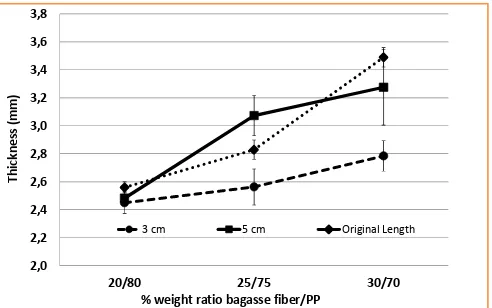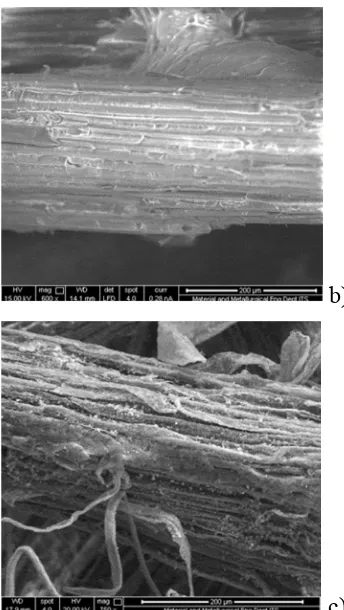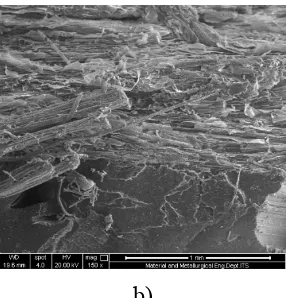Effect of Alkali Treatment Using Calcium Hydroxide and the Fiber
Length on the Strength Of Sugarcane Bagasse Fibers-Polypropylene
Composites
Juliana Anggono,
1,a)Suwandi Sugondo,
1,b)Steven Henrico,
1,c)and Hariyati Purwaningsih
2,d),
1) Department of Mechanical Engineering – Petra Christian University, Surabaya 60236, Indonesia
2) Department of Materials and Metallurgical Engineering, Institut Tekonologi Sepuluh Nopember,
Surabaya 60111, Indonesia
a) julianaa@petra.ac.id, b) aeusug@indo.net.id, c) huangsemin@gmail.com, d) hariyati@mat-eng.its.ac.id
Keywords: alkali treatment, calcium hydroxide, sugarcane bagasse fibers, polypropylene
Abstract. Milling sugarcanes to produce sugar generates by-product called bagasse. Due to the large availability and low cost, the potential of obtaining renewable and biodegradable fibers from bagasse had been explored. To produce fibers from these bagasse, the bagasse was treated in alkali solution using 14 % v/v calcium hydroxide, Ca(OH)2 at high temperature (60-70oC) for 4 hours.
After treatment and washed to remove dissolved substances, the fibers were cut into 3 and 5 cm length. Some fibers were prepared in their original length. These fibers were mixed with polypropylene (PP) matrix in weight % ratios of bagasse fibers/PP 20/80, 25/75, and 30/70 and hotpressed to make composite samples. Composites produced were characterised with tensile test to evaluate their tensile properties. Scanning electron microscopy (SEM) was performed on the fiber surface as well as on the fracture area of the tensile tested samples. Tensile strength of the composite shows an increase with the increase of the fiber length and weight % ratios of bagasse fibers/PP up to 25/75 and decreases when bagasse fibers were added to 30 wt.%. The highest strength of 11,30 MPa was obtained when 5 cm fibers were used in a weight % ratio of bagasse fibers/PP at 25/75. SEM study found a greater number of fibers oriented perpendicular to the tension direction.
Introduction
In recent years there have been a strong motivation in the world society which favors in natural materials to replace non-degradable synthetic materials due to the growth of awareness of global environmental aspects as well as sustainable living. Maximising the use of natural resources, reducing consumption, and recycling are some of the possible approaches to meet that future demands.
Agricultural production inevitably produces by-products (residues) such as leaves and straws that currently become waste and have little use in applications. Sugarcane is one of the main agricultural products in Indonesia after palm oil, coconut, and rubber with its area of plantations in 2012 according to Central Statistics Bureau (Biro Pusat Statistik) covered 198.8 thousand ha.[1] In the sugar mills, bagasse is usually used as fuel for boilers. However, due to its low caloric content, its burning process is inefficient and even cause environmental problems due to the resulting smoke. At the other hand, there are other problems raised concerning storage area for the bagasse and the environment associated with its disposal. Understanding that bagasse is also fibrous residue like other natural fibers, i.e. coir, pineapple fiber, flax fiber and kenaf fiber which they have been used as reinforcing fibers for the manufacturing green composites using polymer matrix, therefore many researchers have performed studies on bagasse fibers as potential reinforcing fibers. Preliminary research has been carried out by studying the effect of variations in the ratio of % weight bagasse/ PP of 20/80; 25/75; and 30/70 on the tensile strength of the composite.[2] The alkali
treatment was applied to reduce the hydrophylicity of fibers which resulted in high moisture absorption and weak adhesion to matrix materials. Bagasse was treated using sodium hydroxide and treated-sugarcane bagasse gave the best reinforcement for composites after 2 hours of treatment due
to the excellent fiber-resin bonding. Pereira et al. applied treatment using sulfuric acid solution on sugarcane bagasse followed with bleaching using acetic acid and sodium chloride.[3] They reported
that after bleaching, the fibers were found rich in cellulose content. This work attempts to study the performances of bagasse fibers/PP composites which the bagasse fibers were treated using calcium hydroxide. Calcium hydroxide was chosen because that alkali solution is less hazardous compared to NaOH. Various length of treated bagasse fibers were prepared including the fibers in their original length. Composite samples were made using various length of fibers then tensile test and SEM study were performed to investigate their strength performance in relation with the microstructure of the fracture cross sectional area. Fourier transform infrared spectroscopy (FTIR) was used to understand the effect of calcium hydroxide treatment given to the bagasse fibers on the fiber surface modification.
Research Methods
Materials Preparation. The raw materials used to produce the composite samples were polypropylene (PP) and sugar cane. They were both available in the fibers form (Fig. 1). PP fibers were obtained from a local carpet industries, PT. Classic Prima Carpet Industries. PP fibers were cut into 1 cm long to ensure a homogenous mixture with bagasse fibres during mixing. Initially, bagasse fibers were neutralised by soaking the fibers in 70% ethanol for 1 hour. This step was done before alkali treatment. Neutralization aimed to prevent the bagasse from degradation due to bacterial fermentation reaction that produced volatile material with an unpleasant smell and acidifying the media used.[4] After drying in the oven at 200oC for 30s, alkali treatment was applied to the bagasse which aimed to remove the layer of lignin and hemicellulose on the fibers surface so that creates good adhesion between the fiber and the matrix. Bagasse was soaked in 14 % v/v Ca(OH)2 heated at 60-70oC for 4 hours. Completing the alkali treatment, bagasse fibers were rinsed
with distilled water for several times. To ensure they were clean from the alkali solution, a pH check on the rinsed water was implemented. The fibers were dried in the oven at 200oC for 30s.
Dried fibers were then cut into 3 cm and 5 cm length. Some were left in their original length.
a) b) c)
Figure 1 Materials used to make composite samples a) PP, b) as-received bagass fibres, and c) treated bagasse fibers
The next step after alkali treatment was mixing the bagasse fibers and PP. A weight total of 60 g consisting of bagasse fibers and PP was placed in a mixer using centrifugal blower. They were mixed for 3 minutes. The mixture was then placed in a hotpress machine which was set at a heating temperature of 175oC and pressure of 9,8 kPa with a duration of 3 minutes. Curing was performed at room temperature. A 38x15 cm2 hotpressed composite was produced and then tensile test
Results And Discussion
Thickness of Composite. Composite thickness was measured from samples used for the tensile test. Thickness was measured using micrometer Links Brand with an accuracy of 0,01 mm. Fig. 2 shows the relationship of composite thickness with fibers length and % wt. ratio of bagasse fibres/PP. The increase in ratio or in number of bagasse fibres added to PP increases the thickness of the composites. That phenomenon was understood that the bagasse fibers which were stiffer than PP formed like a ‘preform’in the mixture. As their amount was increased, they filled in the mould of the hotpress machine and stacked in thicker layer. PP melted during the hotpressing and filled in the spaces among bagasse fibers. Composites which used 3 cm treated fibers have the lowest thickness in all % wt. ratio of bagasse fibres/PP in the range of 2,45-2,78 mm. Fibers with 5 cm length give a composite thickness in a range of 2,48-3,28 mm. As with fibers of original length, the composite thickness is the highest compared to composites using 3 cm and 5 cm fibers, i.e. thickness is 2,56 mm and 3,49 mm in the ratio of 20/80 and 30/70 respectively. Fibers from original length group were taken for sampling and their length was measured. The length data obtained were from 3 to 24 cm and the majority of fibers were with a length of 12-21 cm (70%). This length distribution of bagasse fibers could vary from sample to sample and might give slightly different thickness of the composite produced.
Figure 2 Composite thickness against bagasse fiber length and wt. % ratio of bagasse fiber/PP
Tensile Properties. Composites using untreated fibers were made to study their tensile properties and compared with composites made from treated fibers so that the effect of alkali treatment using Ca(OH)2 can be evaluated. As other previous findings, alkali treated fibers
contributed to a higher composite strength compared to raw or untreated fibers. [5] An increase of
35% in strength was indicated when 25 wt. % of treated fibres were used in the composites (Fig.3a). A decrease of strength was observed when 30 wt. % fibers used both treated and untreated as insufficient PP was available to wet the fibers surface.
Fig. 3b shows the tensile strength of the composites made with different length of treated bagasse fibers in various wt. % ratio of bagasse fiber/PP. The shortest bagasse fibers used, i.e. 3 cm contributed the lowest strength of the composite produced. The reported strength was 4,84 MPa and 5,54 MPa in wt. % ratio of bagasse fiber/PP of 20/80 and 25/75 respectively. The increase of strength to 8,22 MPa when the bagasse fibers added to PP was 30 wt.% needed a further study as the result was quite different from the composites using different fiber length. The trend shown from tensile test results in Fig. 3 is an increase in strength when bagasse fibers added up to wt. % ratio of bagasse fiber/PP 25/75 and the strength decreases when the ratio is increased to 30/70. Increasing wt. % ratio of bagasse fiber/PP from 20/80 to 25/75 resulted in a strength increase of 33% from 8,51 MPa to 11,30 MPa in composites using 5 cm fibers. As with composites employing fibers with original length, there was not found a significant increase in strength with the ratio. The strength continued to drop when the bagasse fibers were added to 30 wt.%.[2] The drop in strength
fibers resulting in poor interfacial fiber-matrix adhesion therefore it decreases the strength of the composites at fiber content of 30 wt.%.
a) b)
Figure 3 Tensile strength of composite samples a) using original length of fibers - comparing treated and untreated fibers and b) different fiber length and % wt. ratio of bagasse fiber/PP
Structural Characterization. Bagasse fibers in isolation were examined using FTIR and SEM. Fig. 4a shows the FTIR spectra from untreated and 4-hour treated fibers.
a)
Figure 4 a) FTIR Spectra of untreated and treated bagasse fibers b) and c) SEM micrographs of untreated fibers and treated fibers respectively.
b)
c)
The components of bagasse include cellulose 43.8%, hemicellulose 28.6%, lignin 23.5%, ash 1.3%, and other components 2.8%.[6] They can vary depending on the climate, soil condition,
and the crop age of plant. The CH stretch at 2894 cm-1 is present in both untreated and treated fibers. The obvious differences between the untreated bagasse fibers and treated fibers were noted in the range from 2000-700 cm-1. The peak 1730 cm-1 indicates the C=O stretching of the acetyl
groups of hemicellulose [7,8] and only shown in untreated fibers. The disappearance of that peak indicates the removal of hemicellulose from the fiber surfaces after treatment. There is an indication of carbonate peaks in the range of 1500-1400 and 872 cm-1. The spectra 1250 cm-1 which is a lignin
spectrum was no longer found in sugar cane fibers that have been given alkali treatment. SEM study was performed to confirm the influence of alkali treatment on fiber surface. SEM micrograph on
Fig. 4b shows surface of untreated fiber. Fig. 4c shows morphological changes as a consequence of lignin and hemicellulose removal from the surface. The micrograph shows fibrilation of cellulose bundle with bright small particles deposited on the surface of treated fibers. Those particles were identified by EDX analysis having calcium. These particles can be related with identification of CaCO3 in the FTIR spectra.
Fig.5 shows microstructure at the fracture surface of composite sample using 5 cm fibers with 20/80 wt.% ratio of bagasse fibers/PP demonstrating fibers clustering in the composites (Fig.5a). Another observation in Fig. 5b reveals the clustering of fibers and lack of PP matrix. It was observed the orientation of some fibers in the composites was in transversal direction (Fig. 5b). All those microstructural data explained the small increase in strength obtained in the composites using treated fibers.
a) b)
Figure 5 SEM micrographs on fracture surface of composite sample using 5 cm fibers with 20/80 wt.% ratio of bagasse fibers/PP. The micrographs show a) fibers clustering and b) orientation of fibers in transversal direction.
Conclusions
Alkali treatment using 14% v/v Ca(OH)2 bagasse fibers in solution has removed lignin and
hemicellulose as shown with FTIR and SEM study. Composite thickness increases with fiber length as well as with weight ratio of bagasse/PP. The strength of the composites was affected by the fiber length and alkali treatment. The highest tensile strength (11,30 MPa) was obtained in composites with bagasse/PP weight ratio of 25/75 and fiber length 5 cm.
Acknowledgements
We thank Mr. Martinus Salombek and Ms. Russava Istiani for their assistance with materials characterization.
References
[1]. Information on http://www.bps.go.id /menutab.php?tabel=1&kat= 3 & id_subyek = 54.
[2]. J. Anggono, N. R. Habibi, S.Sugondo, in: Alkali Treatment On Sugarcane Bagasse To Improve Properties Of Green Composites Of Sugarcane Bagasse Fibers-Polypropylene, edited by Dileep Singh and Jonathan Salem, Volume 35, Issue 2 of Ceramic Engineering and Science Proceedings, - Mechanical Properties and Performance of Engineering Ceramics and Composites IX, p. 139, John Wiley (2014).
[3]. P.H.F. Pereira, et al.: Bioresources 6 (3) (2011), p. 2471-2482.
[4]. J.L. Leite et al.: Brazilian Journal of Chemical Engineering, 21(2) (2004), p. 253-260. [5] D. Verma, et al.: J. Mater. Environ. Sci., 3 (6) (2012), p. 1079-1092.
[6] S. M. Luz, A.R. Gonçalves, and A.P. Del‘Arco, Jr: Composites Part A: Applied Science and Manufacturing 38(6) (2007), p. 1455-1461.



